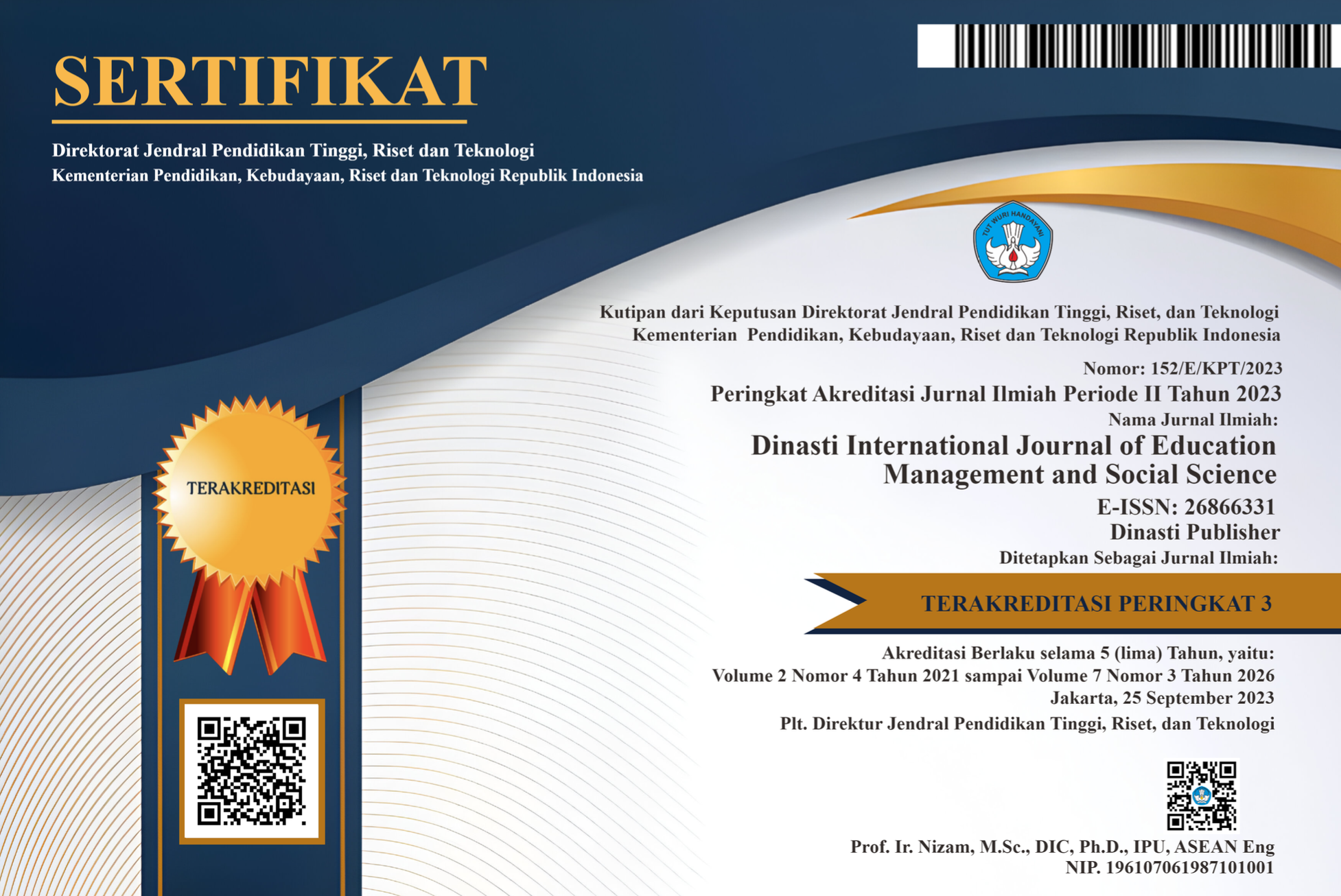Analysis of Communication Privacy Management on TikTok
DOI:
https://doi.org/10.38035/dijemss.v6i5.4606Keywords:
Social Media, TikTok, Communication Privacy Management , Gen-ZAbstract
Social media is a digital platform that allows people to create, share and exchange information, ideas and content in various formats, such as text, images, video and audio. It allows people and groups to interact over the internet, allowing them to interact with each other in real time or asynchronously. This research aims to find out how Gen-Z carries out privacy management on the TikTok application. The research was conducted qualitatively by conducting in-depth interviews with a total of three informants with an analysis method using Communication Privacy Management (CPM) theory. The results of this research are that privacy settings in the TikTok application are important and must be maintained by users. The conclusion of this research is related to how users use privacy restrictions on their respective accounts. The results of the research findings can also provide theoretical implications, namely these findings can explain that issues related to privacy in an application like TikTok are very important and as a user you must understand this before or when using the application. The practical implications are that TikTok users can take advantage of the features provided by the application as an effort to protect the privacy of their communications.
References
Barta, K., & Andalibi, N. (2021). Constructing authenticity on TikTok: Social norms and social
support on the“fun” platform. Proceedings of the ACM on Human-Computer Interaction, 5(CSCW2), 1–29. https://doi.org/10.1145/3479574
Browning, Blair & Sanderson, Jimmy. (2012). The positives and negatives of Twitter: Exploring how student-athletes use Twitter and respond to critical tweets. International Journal of Sport Communication, 5, 503-521.
Child, Jefferey & Agyeman-Budu, Esther A. (2010). Blogging privacy management rule development: The impact of self-monitoring skills, concern for appropriateness, and blogging frequency. Computer in Human Behavior, 26, 957-963.
Griffin, E. M., Ledbetter, A., & Sparks, G. (n.d.). A FIRST LOOK AT COMMUNICATION THEORY TENTH EDITION.
Howard, P. N., & Parks, M. R. (2012). Social media and political change: Capacity, constraint, and consequence. Journal of Communication, 62, 359–362. doi:10.1111/j.1460-2466.2012.01626.x
Kaplan, A. M., & Haenlein, M. (2010). Users of the world, unite! The challenges and opportunities of social media. Business Horizons, 53, 59–68. doi:10.1016/j.bushor.2009.09.003
Kennedy-Lightsey, C. D., Martin, M. M., Thompson, M., Himes, K. L., & Clingerman, B. Z. (2012). Communication Privacy Management Theory: Exploring Coordination and Ownership Between Friends. Communication Quarterly, 60(5), 665–680. https://doi.org/10.1080/01463373.2012.725004
Kennedy, M. (2020). ‘If the rise of the TikTok dance and e-girl aesthetic has taught us anything, it’s that teenage girls rule the internet right now’: TikTok celebrity, girls and the Coronavirus crisis. European Journal of Cultural Studies, 23(6), 1069–1076. https://doi.org/10.1177/1367549420945341
Kent, M. L. (2010). Directions in social media for professionals and scholars. In R. L. Heath (Ed.), Handbook of public relations (2nd ed., pp. 643–656). Thousand Oaks, CA: Sage.
Kartini, K., Gultom, N., Sari, N., & Annisa, A. N. (2023). Penelitian Sejarah Sosial Media . Da’watuna: Journal of Communication and Islamic Broadcasting, 3(3). https://doi.org/10.47467/dawatuna.v3i3.3024
Krasnova, H., Veltri, N. F., & Günther, O. (2012). Self-disclosure and privacy calculus on social networking sites: The role of culture. Business & Information Systems Engineering, 4(3), 127–135. https://doi.org/10.1007/s12599-012-0216-6
Lamont, T. (2020, June 6). ‘It’s hard to put the brakes on it: We doubled down’: Charli D’Amelio and the first family of TikTok. The Guardian. https://www.theguardian.com/lifeandstyle/2020/jun/06/its-hard-to-put-the-brakes-on-it-we-doubled-down-charli-damelio-and-the-first-family-of-tiktok#
Management Perspective, Communication Studies, 63:1, 54-76, DOI: 10.1080/10510974.2011.616569
O’Reilly, T. (2006). Web 2.0 compact definition: Trying again. Retrieved from http://radar.oreilly.com/2006/12/web-20-compact-definition-tryi.html
Petronio, S. (2002). “Boundaries of Privacy: Dialectics of Disclosure,”. State University of New York Press, Albany.
Petronio, S. (2013). Brief Status Report on Communication Privacy Management Theory. Journal of Family Communication, 13(1), 6–14. https://doi.org/10.1080/15267431.2013.743426
Petronio, S., & Child, J. T. (2020). Conceptualization and operationalization: utility of communication privacy management theory. In Current Opinion in Psychology (Vol. 31, pp. 76–82). Elsevier B.V. https://doi.org/10.1016/j.copsyc.2019.08.009
Pryde, S. & Prichard, I. (2022). TikTok on the clock but the #fitspo don’t stop: The impact of TikTok fitspiration videos on women’s body image concerns. Body Image: Volume 43, December 2022, Pages 244-252 https://doi.org/10.1016/j.bodyim.2022.09.004.
Reuter, C., & Kaufhold, M. (2018). Fifteen years of social media in emergencies: A retrospective review and future directions for crisis Informatics. Journal of Contingencies and Crisis Management, 26(1). https://doi.org/10.1111/1468-5973.12196
Ritholz, B. History of social media. Retrieved December 05, 2010, http://www.ritholz.com/blog/2010/12/history-of-social-media/
Snyder E. M. (2014). An examination of student-athlete perceptions of division I social media
policies. Journal of Issues in Intercollegiate Athletics, 7, 132-160.
Stutzman, F., & Hartzog, W. (2012). Boundary regulation in social media. In Proceedings
of the ACM 2012 conference on Computer Supported Cooperative Work (CSCW '12). Association for Computing Machinery, New York, NY, USA, 769–778. https://doi.org/10.1145/2145204.2145320
Sun T, Lim CC.W, Chung J, et al. Vaping on TikTok: a systematic thematic analysis. Tob
Control 2023;32:251–254. doi:10.1136/tobaccocontrol-2021-056619
Terry, M. (2009). Twittering healthcare: Social media and medicine. Telemedicine and e-
Health, 15, 507–510. doi:10.1089/tmj.2009.9955
Thompson, Jason. (2011). Communication privacy management in college athletics: Exploring privacy dilemmas in the athletic/academic advisor student-athlete interpersonal relationship. Journal of Sport Administration and Supervision, 3(1), 44-60.
Thompson, J., Petronio, S., & Braithwaite, D. O. (2012). An Examination of Privacy Rules for Academic Advisors and College Student-Athletes: A Communication Privacy Management Perspective, Communication Studies, 63:1, 54-76, DOI: 10.1080/10510974.2011.616569
Trifiro, B. M. (2023). Breaking Your Boundaries: How TikTok Use Impacts Privacy Concerns Among Influencers, Mass Communication and Society, 26:6, 1014-1037, DOI: 10.1080/15205436.2022.2149414
Waters, S., & Ackerman, J. (2011). Exploring privacy management on Facebook: Motivations and perceived consequences of voluntary disclosure. Journal of Computer-Mediated Communication, 17(1), 101-115.
Weimann, G., & Natalie Masri, N. (2023). Research Note: Spreading Hate on TikTok, Studies in Conflict & Terrorism, 46:5, 752-765, DOI: 10.1080/1057610X.2020.1780027
Downloads
Published
How to Cite
Issue
Section
License
Copyright (c) 2025 Gabriella Nikita, Sandi Dwi Ariadi, Timotius Christian

This work is licensed under a Creative Commons Attribution 4.0 International License.
Authors who publish their manuscripts in this journal agree to the following conditions:
- The copyright on each article belongs to the author(s).
- The author acknowledges that the Dinasti International Journal of Education Management and Social Science (DIJEMSS) has the right to be the first to publish with a Creative Commons Attribution 4.0 International license (Attribution 4.0 International (CC BY 4.0).
- Authors can submit articles separately, arrange for the non-exclusive distribution of manuscripts that have been published in this journal into other versions (e.g., sent to the author's institutional repository, publication into books, etc.), by acknowledging that the manuscript has been published for the first time in the Dinasti International Journal of Education Management and Social Science (DIJEMSS).















































